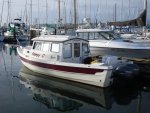For those of us who keep our Dory's in the water, marina or mooring buoy, most of the time (spring/summer/fall), should the outboard(s) be left in the down position or raised?
I asked a Yamaha mechanic, and he said "down". Something to do with oil and lubricants. Yet when I look around my own marina, most outboards are in the raised position!
I tried to find the answer on our 'C-Brats Google Search', but had no luck. Hope I'm not re-hashing an old topic here.
Martin.
I asked a Yamaha mechanic, and he said "down". Something to do with oil and lubricants. Yet when I look around my own marina, most outboards are in the raised position!
I tried to find the answer on our 'C-Brats Google Search', but had no luck. Hope I'm not re-hashing an old topic here.
Martin.


